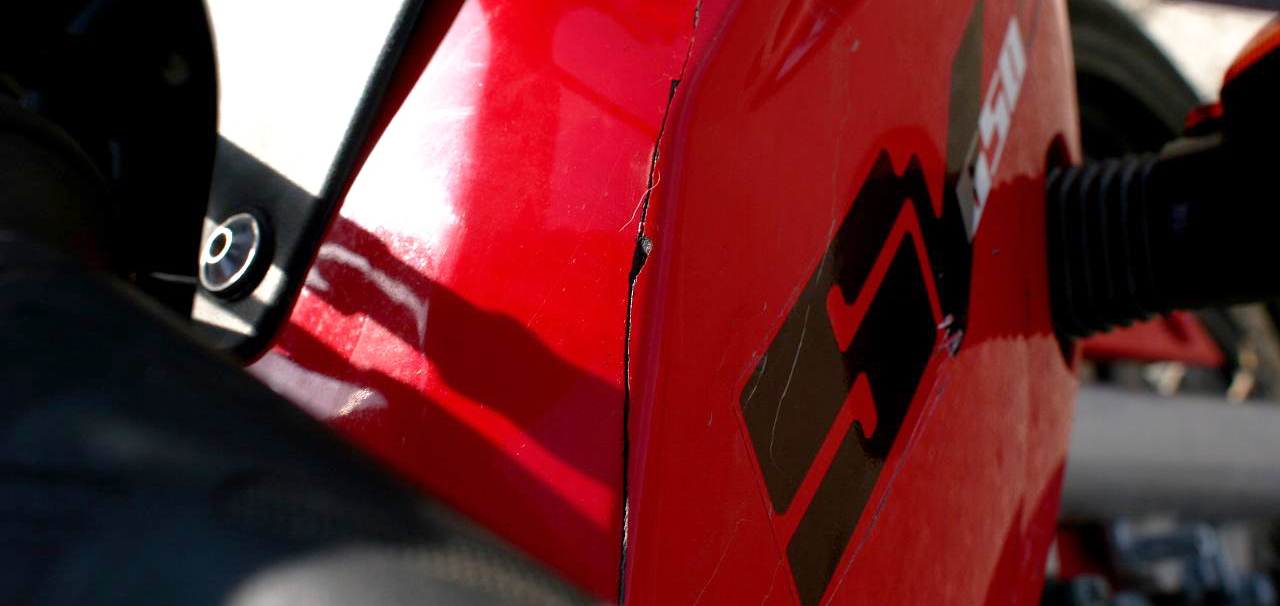Our blockbuster FTC disclosure awaits here. The following article was last updated on Apr 4, 2022 ...
Plastic Repair: Glues, Welds and UV Agents
I have a vested interest in this article's headline topic not because I'm soft-selling worthwhile products (as usual) but because my beloved Suzuki Bandit 1200 is beginning to show its age. Some refer to each of 'er scratches, dents and hardware store "solutions" as character ... and they're right. That bike and I have aged together for the better. Each physical or emotional scar comes from nature's blunt response to riding/wrenching ignorance. Of course, earning such wisdom also expands the winter project laundry list via sometimes costly upgrades.
“Before paying to replace broken plastics, why not learn to repair cracked plastic and attempt to fix it yourself?”
One aesthetic concern that's remained constant in modern motorcycling is the eventual lack of OEM plastics for any given model. Where metallurgical solutions might be as simple as "knowing a guy", plastic body repair is a more difficult matter. Not every rider sees that broken fairing, side panel or cowling as a candidate for fixing, instead opting to search Craigslist, eBay and model-specific forums for that unfortunate, "least damaged" replacement.
If you're going to swap out a shattered plastic tail section, why not learn how to repair cracked plastic and attempt to remedy the situation yourself? Worst case scenario, you revert to your original plan, employing whatever used and aftermarket resources you have. Set your sights on the following plastic repair options before choosing one that best fits your situation ...
Liquid Plastic Welder (Bondic)
Whenever TRO authors attend a promotional event (such as the IMS), we make a point to look at anything and everything with quick-scan impatience. Already established products get sidestepped for that which is truly new. In the case of Bondic, we were flat out hypnotized.
Bondic isn't a glue or bonding agent until you tell it to be. It maintains liquid form both in an out of it's container for many years over. Only after you hit it with a UV/LED strobe does it instantly harden, boasting enough strength to suspend 500+ lbs!
Heat Based Plastic Welding
If for some reason Bondic won't do the job, tried and true mechanic's methods may come into play. Heat welding body parts and internal plastics might read as challenging but it's really quite simple. Some techniques require a splint. Others call for staples. Either way, you'll want to have your soldering gun, butane torch and welding rods (or zip ties) on hand.
If greater strength and support is needed, consider bringing a hot stapler (and staples) into the mix. These embed a sort of metallic skeleton across broken sections you're aiming to join. Once locked in place and fully cool, cut away the excess and file things down accordingly.
Should you wish to bolster things even further, an additional option would be to drape/weld FiberFlex over the affected area. This approach uses both stainless steel mesh and plastic welding rods to reinforce the targeted location. Said process is all about heat, with minimal pressure if any.
No matter which of the above heat based plastic welding options you put to practice, your results are likely to be far better than that of fiberglass and epoxy. It's not that such old school fixes aren't functional. It's that they're less efficient, producing brittle (fragile) post-repair concerns.
Non-Exposed (Hidden) Plastics Repair
If the damage to your bike is out of sight but not out of mind, a two-part powder adhesive may have you covered. I can't plainly tell if Plastex and our DIY version are one in the same (keep reading) but the after effects appear to be similar. Plastex kits include separate powder/liquid containers and an applicator for each respective dispenser attachment. It hardens to form a reliably strong concrete of sorts. Plasticrete, maybe?
Another possibility is to use a standard household super glue in song with baking powder. Yes you read that right. By layering powder over glue repeatedly, a heat-generating chemical reaction helps drive it between broken openings. It then bridges those gaps in a poxy-esque fashion.
Be it Plastex, "Super Soda" or any of the aforementioned tactics in this article, make sure you're in a well ventilated area before getting started. Heat and super glue, for example can quickly become a toxic airborne scenario. For this reason, we recommend investing in a respirator.
Our Summary On How to Repair Motorcycle Plastic
In the end, the key ingredient to motorcycle plastic repair is in identifying which technique will both strengthen the resulting fix and offer an aesthetically pleasing appearance. No matter which approach you take, practice makes perfect. You've likely got some useless bits and pieces lying around to test on so watch, learn and try before giving it a go!

What Plastic Repair Techniques Do You Prefer?
There are other useful suggestions regarding how to repair cracked plastic on the web. Which methods have you used? What were the pros/cons and why? Your input is invited. Leave a comment!



Comments
Would one ever repair a crack in a vinyl motorcycle windshield with these methods?
Not likely, unless it's opaque. Repairing clear plastics via the above will have poor/negative results.